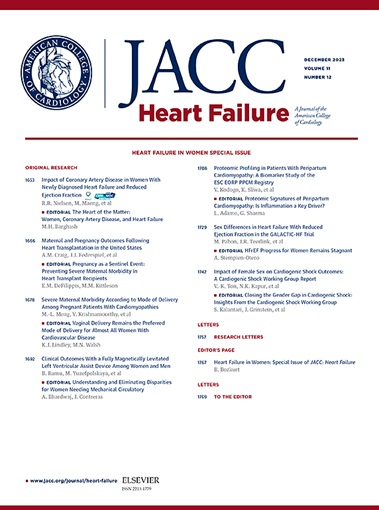Interaction Between Aldosterone and Mineralocorticoid Receptor Antagonist
IF 10.3
1区 医学
Q1 CARDIAC & CARDIOVASCULAR SYSTEMS
引用次数: 0
Abstract
Background
Mineralocorticoid receptor antagonists (MRAs) block the activation of mineralocorticoid receptors by aldosterone, thereby mitigating cardiovascular risks. However, data on whether impact of aldosterone on outcomes differs with MRA use remain limited.
Objectives
The study aims to explore the associations between baseline aldosterone, its changes and outcomes, and their interaction with eplerenone.
Methods
In a subset of the EPHESUS (Eplerenone Post-Acute Myocardial Infarction Heart Failure Efficacy and Survival Study) trial, associations between baseline serum aldosterone concentrations, their changes from baseline to month 1, and outcomes were separately assessed in the eplerenone and placebo groups. The primary outcome was a composite of cardiovascular death or heart failure (HF) hospitalization.
Results
Among 453 patients (mean age: 62 ± 11 years; 75% male), baseline median serum aldosterone was 5.6 ng/dL (Q1-Q3: 3.1-9.2 ng/dL). Higher baseline serum aldosterone was associated with primary outcome in the placebo group (HR per 1 ng/dL: 1.04 ng/dL [95% CI: 1.02-1.07 ng/dL]; P = 0.002), but not in the eplerenone group (HR per 1 ng/dL: 0.99 ng/dL [95% CI: 0.93-1.05 ng/dL]; P = 0.64; P for interaction = 0.048), and these associations persisted after covariate adjustment (ie, prior HF history and renal function). At month 1, eplerenone increased serum aldosterone more than placebo (P < 0.001). High serum aldosterone changes (≥ median value) were associated with increased risk of primary outcome in the placebo group but not in the eplerenone group (HR: 3.48 [95% CI: 1.35-8.99]; P = 0.01 in placebo; HR: 0.81 [95% CI: 0.36-1.82]; P = 0.60 in eplerenone; P for interaction = 0.046), and these associations persisted after covariate adjustment.
Conclusions
In patients with left ventricular systolic dysfunction and/or HF after myocardial infarction, higher baseline or rising aldosterone levels were associated with increased risk of HF events. However, eplerenone mitigated aldosterone-associated risks.
醛固酮与矿物皮质激素受体拮抗剂的相互作用
背景:矿化皮质激素受体拮抗剂(MRAs)阻断醛固酮对矿化皮质激素受体的激活,从而降低心血管风险。然而,关于醛固酮对MRA使用结果的影响是否不同的数据仍然有限。目的探讨基线醛固酮、其变化和预后之间的关系,以及它们与eplerenone的相互作用。方法在EPHESUS(依普利酮急性心肌梗死后心力衰竭疗效和生存研究)试验的一个亚组中,分别评估依普利酮组和安慰剂组的基线血清醛固酮浓度、基线至第1个月的变化和结局之间的相关性。主要结局是心血管死亡或心力衰竭住院。结果453例患者(平均年龄62±11岁;75%为男性),基线血清醛固酮中位数为5.6 ng/dL (Q1-Q3: 3.1-9.2 ng/dL)。在安慰剂组中,较高的基线血清醛固酮与主要结局相关(HR / 1 ng/dL: 1.04 ng/dL [95% CI: 1.02-1.07 ng/dL];P = 0.002),但eperenone组没有(HR每1 ng/dL: 0.99 ng/dL [95% CI: 0.93-1.05 ng/dL];P = 0.64;P为相互作用= 0.048),这些关联在协变量调整后仍然存在(即既往HF病史和肾功能)。在第1个月,依普利酮比安慰剂增加血清醛固酮(P <;0.001)。高血清醛固酮变化(≥中值)与安慰剂组的主要结局风险增加相关,但与依普利酮组无关(HR: 3.48 [95% CI: 1.35-8.99];安慰剂组P = 0.01;Hr: 0.81 [95% ci: 0.36-1.82];eperenone组P = 0.60;P为相互作用= 0.046),协变量调整后这些关联仍然存在。结论在心肌梗死后伴有左室收缩功能不全和/或心衰的患者中,较高的基线水平或升高的醛固酮水平与心衰事件的风险增加相关。然而,eperenone减轻了醛固酮相关的风险。
本文章由计算机程序翻译,如有差异,请以英文原文为准。
求助全文
约1分钟内获得全文
求助全文
来源期刊

JACC. Heart failure
CARDIAC & CARDIOVASCULAR SYSTEMS-
CiteScore
21.20
自引率
2.30%
发文量
164
期刊介绍:
JACC: Heart Failure publishes crucial findings on the pathophysiology, diagnosis, treatment, and care of heart failure patients. The goal is to enhance understanding through timely scientific communication on disease, clinical trials, outcomes, and therapeutic advances. The Journal fosters interdisciplinary connections with neuroscience, pulmonary medicine, nephrology, electrophysiology, and surgery related to heart failure. It also covers articles on pharmacogenetics, biomarkers, and metabolomics.
 求助内容:
求助内容: 应助结果提醒方式:
应助结果提醒方式:


